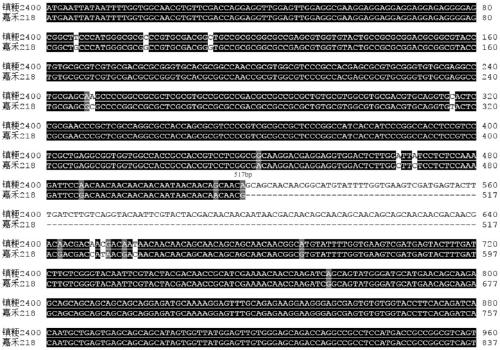Photoperiod-insensitivity Hd1 allele and molecular marker and application thereof
An allele and molecular marker technology, applied in the field of molecular breeding, can solve the problems of low accuracy and inconvenient distinction, and achieve the effects of stable expression of gene function, improved photosensitivity, improved regional adaptability and breeding efficiency.
- Summary
- Abstract
- Description
- Claims
- Application Information
AI Technical Summary
Problems solved by technology
Method used
Image
Examples
Embodiment 1
[0039] Embodiment 1 Obtaining of photoperiod insensitive rice mutant material
[0040] The rice varieties of Zhendao series (Zhendao 18, Zhendao 19 and intermediate materials, etc.) were subjected to MNU (methylnitrosourea) mutagenesis. The mutagenesis method is as follows:
[0041] (1) Select a single plant that has been headed but only has a small amount of flowering at the top, preferably each single plant has about 3-4 ears;
[0042] (2) Cut off the flowering florets of the selected plants in the field in the afternoon of the first day, leave the florets that have not yet bloomed, and put them on a sign to mark them;
[0043] (3) Let the individual plant bloom on its own in the morning the next day, and after the flowering finishes in the afternoon, cut off the spikelets that have not yet bloomed, leaving only the spikelets that bloomed that day, and pruning off the tillers that are not heading;
[0044] (4) Dig out the listed plants, try to ensure the integrity of the ro...
Embodiment 2
[0050] Example 2 Acquisition of photoperiod insensitivity Hd1 allele and development of molecular markers
[0051] 1. F of Zhenjing 2400 / Jiahe 218 2 Population construction and phenotyping
[0052] (1) A hybrid F 1 , constructed the F of Zhenjing 2400 / Jiahe 218 2 Separation population, a total of 247 copies; each F 2 The corresponding Zhenjing 2400 / Jiahe 218 F 2:3 family lineage.
[0053] (2) Phenotype identification
[0054] The constructed population and family materials were planted in the variety target promotion area and Hainan respectively, the date of full ear was investigated, the sowing period (days from sowing to full ear) was calculated, and the phenotype identification was carried out, as follows:
[0055] The above-mentioned rice materials are planted twice a year. The first season is planted in the Xingxiang Experimental Base of Zhenjiang Agricultural Science Research Institute in the hilly area of Jiangsu. Sowing on May 15, transplanting on June 15, sing...
PUM
 Login to View More
Login to View More Abstract
Description
Claims
Application Information
 Login to View More
Login to View More - R&D Engineer
- R&D Manager
- IP Professional
- Industry Leading Data Capabilities
- Powerful AI technology
- Patent DNA Extraction
Browse by: Latest US Patents, China's latest patents, Technical Efficacy Thesaurus, Application Domain, Technology Topic, Popular Technical Reports.
© 2024 PatSnap. All rights reserved.Legal|Privacy policy|Modern Slavery Act Transparency Statement|Sitemap|About US| Contact US: help@patsnap.com










